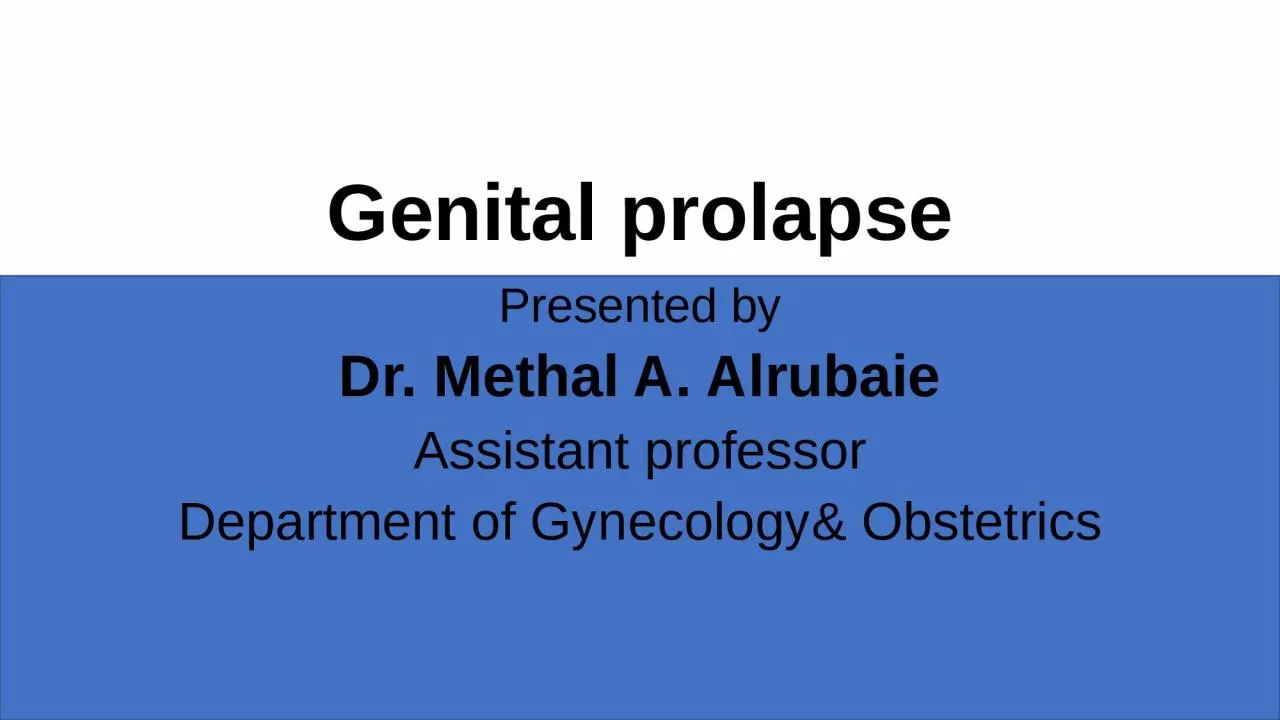

Dr Methal A Alrubaie Assistant professor Department of Gynecologyamp Obstetrics Objectives What is the definition of genital prolapse How we classify this condition How frequent genital prolapse affect the women ID: 917228
Download Presentation The PPT/PDF document "Genital prolapse Presented by" is the property of its rightful owner. Permission is granted to download and print the materials on this web site for personal, non-commercial use only, and to display it on your personal computer provided you do not modify the materials and that you retain all copyright notices contained in the materials. By downloading content from our website, you accept the terms of this agreement.
Slide1
Genital prolapse
Presented by
Dr.
Methal
A.
Alrubaie
Assistant professor
Department of Gynecology& Obstetrics
Slide2Objectives
What is the definition of genital prolapse.
How we classify this condition.
How frequent genital prolapse affect the women.
What are the etiology behind this problem.
How we can diagnose the prolapse from clinical features & examination.
What are the methods of treatment.
Slide3Definition:-
It is the descent of an organ beyond its normal confines.
Classification:-
1. Anterior vaginal wall prolapse:-
a.
Urethrocele
:-
Descent of urethra.
b. Cystocele:-
Descent of bladder.
C.
Cysto-urethrocele
:-
Descent of both urethra & bladder.
2.Posterior vaginal wall prolapse:-
a. Rectocele:-
Descent of rectum.
b
.
Enterocele:-
Descent of small bowel.
3.Apical-vaginal prolapse:-
a. Utero-vaginal:-
Descent of uterus with inversion of vaginal apex.
b. Vault prolapse:-
Post-hysterectomy inversion of vaginal apex.
Slide44. Uterine prolapse:-
It is of three types:-
a. First degree:-
Descent of uterus within vagina.
b. Second degree:-
Descent of uterus down up to introits (vaginal orifice).
. c. Third degree:-
Descent of uterus out of introits & called(
procedentia
). It is usually associated with cystocele & rectocele
.
Incidence:-
It affect (2%) of nulliparous & (12-30%) of multiparous. They have (11%) risk of having operation for genital prolapse during their life time.
Etiology:-
1. Congenital:-
Congenital connective tissue defect play important role in the etiology of genital prolapse & stress incontinence. This explain symptomatic prolapse in nulliparous.
Slide52.
Vaginal delivery:-
It cause damage to
levator-ani
muscle & nerve damage. WHO suggested that there is risk of prolapse (7) times in those who had more than (7) children compared to those who had one.
3. Aging:-
Loss of collagen & weakness of pelvic fascia can cause prolapse so it is common in postmenopausal women due to lack of estrogen.
4. Postoperative:-
Poor attention to the vault support during hysterectomy lead to vault prolapse in (1%). Mechanical displacement by colposuspension (operation for stress incontinence) can cause enterocele & rectocele.
5. Pregnancy:-
It is rare. It is mediated by the progesterone & relaxin hormones in addition to increased intra-abdominal pressure which put added strain on pelvic floor.
Slide6Pathophysiology:
-
Three component are responsible for the support of uterus & vagina in position
.
1. Ligaments & fascia by suspension from pelvic side wall. 2.
Levator
ani
muscle by constricting & maintain the organ position. 3. Posterior angulation of vagina which is enhanced by raised intra-abdominal pressure.
Clinical features:-
Symptoms:- a. Non specific:-
1. Feeling of lump coming through introits. 2. Local discomfort. 3. Backache. 4. Superficial dyspareunia. 5. Vaginal bleeding if cervical ulceration occur. 6. Rarely acute renal failure due to sever kinking of ureter.
Slide7B. Specific:- 1.
Cysto-urethrocele
:-
Frequency, urgency, voiding difficulties, recurrent U.T.I. & stress incontence.
2.Rectocele:-
Incomplete bowel emptying.
3.Uterine prolapse:-
Profuse vaginal discharge & bleeding if there is cervical ulcer.
Signs:-
The patient should examined in left lateral position using (
Sims speculum)
to asses the anterior & posterior vaginal wall as well as cervical descent by asking the patient to push down. In dorsal position the prolapsed organ may be visible through introits. By combined rectal & vaginal digital examination we can differentiate between rectocele&
enterocele
.
Slide8Prevention:-
1. Shorten second stage of labor. 2. Avoid traumatic delivery. 3. The benefit of episiotomy & hormonal replacement in menopausal women have not sub stained.
Differential diagnosis:-
1. Congenital vaginal cyst. 2. Vaginal inclusion dermoid cyst. 3. Urethral diverticulum. 4. Large uterine polyp.
Treatment:-
1. Medical treatment:- *Rubber silicon-based ring
is the most common conservative method. *It is complicated by vaginal infection & ulceration. *It should changed at annual interval.
Slide9*
Indicated in the following:- a. As patient wish. b. As therapeutic test to see if the symptoms is due to prolapse or not. c. If the patient not complete her family. d. If she is medically unfit for surgery. e. During & after pregnancy. f. Waiting for surgery. * the ring is available in different size so the choice of the size depend on the size of vagina.
2. Surgical treatment:-
The aim is to restore the anatomy & function of prolapsed organ.
Cysto-urethrocele
:-
treated by (
Anterior repair or colporrhphy)
which
is the commonest type but should avoided if there is concurrent stress incontence.
Slide10Rectocele:-
It is treated by (
posterior repair or
colporrhaphy
)
which has the same principles as the anterior repair but the act on posterior vaginal wall.
Utero-vaginal prolapse:- 1. Manchester operation
:- *
Indicated in those who wish to conserve uterus for fertility. * Involve partial amputation of the cervix with approximation of cardinal ligament below the retained cervix. * Usually associated with anterior & posterior repair. * It is complicated by cervical incompetence.
2. Vaginal hysterectomy:-
Indicated in those with third degree prolapse, those not want to conserve uterus & in menopausal women.
Slide113.
Sacro-hysteropexy
:-
It is an abdominal operation done if uterine conservation is required. The utero-sacral junction is attached to longitudinal ligaments of sacrum using synthetic mesh then close pouch of Douglas (P.O.D.).
4. Vault prolapse:- 1.
sacro-colpopexy
:-
It is similar to
sacro-hysteropexy
but the inverted vaginal vault is attached to sacrum using synthetic mesh.
2.
Sacro-spinous
fixation:-
It is done through vaginal route where the vaginal vault is attached to lateral ligaments of
ischeal
spine.
Slide12Thank you